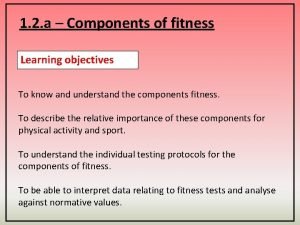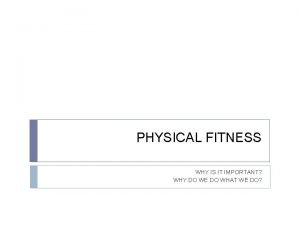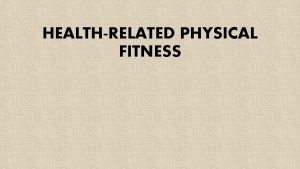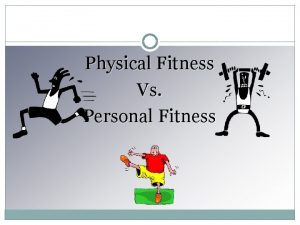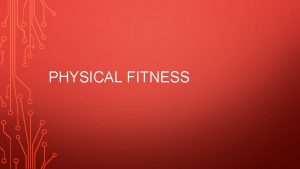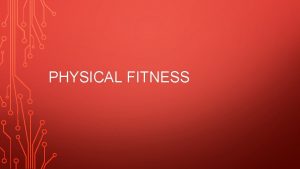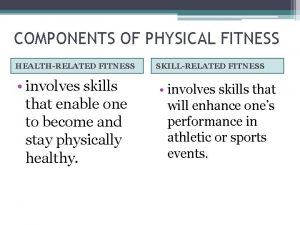Physical Fitness HealthRelated Physical Fitness Tests Physical Fitness











- Slides: 11

Physical Fitness Health-Related Physical Fitness Tests

Physical Fitness Indicates that there is a smooth relationship between the work of your skeleton, muscles, heart and the lungs to carry out your daily activities.

FITNESS It involves strength, stamina and flexibility. Fitness testing activities and basic exercise that will help you decide the type of exercise that is best for you and plan the kind of activities that suits your needs.

Health-Related Physical Fitness Components Assessment/Test Anaerobic Capacity Shuttle run Muscular Strength &Endurance Right Angle Push-ups Partial Curl-ups Muscular Flexibility Sit and Reach Aerobic Capacity Pacer Test Body Mass Index Body Mass (kg) ÷ Height (meter squared)

Anaerobic Capacity -It is your body’s capacity to use its systems without oxygen. HRPFT: Shuttle Run

Muscular Strength & Endurance Strength is a measure of how much force your muscles can exert, while endurance is the measure of how many times your muscles can repeat a specific exertion of force.

Muscular Flexibility Absolute range of movement of a muscle.

Aerobic Capacity Aerobic capacity is the maximum amount of oxygen a body can use in a physical activity.

BODY MASS INDEX (BMI) It indicates whether one is of normal weight, underweight, overweight, or obese. Body Mass (kg) ÷ Height (meter squared)

BMI Standard Less than 15 15. 0 – 18. 5 18. 6 – 24. 9 25. 0 – 29. 9 30. 0 – 40. 0 Greater than 40 - starvation underweight normal overweight obese morbidly obese

Example: Height = 1. 54 m Weight = 45 kg 45÷(1. 54)²=N 45÷ 2. 37 = 18. 99 Normal
 Physical fitness test grade 9
Physical fitness test grade 9 Ace different help iq tests but
Ace different help iq tests but Gaa fitness tests
Gaa fitness tests Health related skill
Health related skill What component of fitness is ruler drop test
What component of fitness is ruler drop test 6 components of skill-related fitness.
6 components of skill-related fitness. Ppft exercises
Ppft exercises Trunk lift test
Trunk lift test Hexagon agility test average
Hexagon agility test average Alabama physical fitness assessment
Alabama physical fitness assessment Chapter 6 physical fitness for life
Chapter 6 physical fitness for life Physical fitness
Physical fitness




